Engaging in music and movement activities during the preschool years goes beyond mere entertainment; it lays the foundation for a lifetime of learning, growth, and enrichment. The power of music to shape young minds is truly remarkable. Singing songs, dancing to rhythms, and exploring musical instruments are not just enjoyable pastimes; they are integral components of a child’s developmental journey.
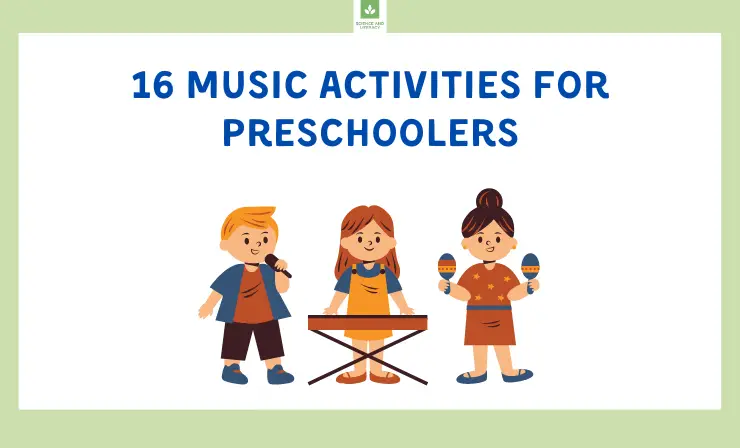
Research has shown that music plays a pivotal role in a child’s overall development, impacting various facets of their growth. When children sing along to songs, they’re not just memorizing melodies; they’re enhancing their language development. The rhythmic patterns, rhyme schemes, and cadence of music help refine their linguistic skills, boosting vocabulary acquisition and sentence structure.
Dance, on the other hand, isn’t just about moving to a beat. It’s a dynamic form of self-expression that cultivates gross motor skills and coordination. As preschoolers sway, jump, and twirl to the music, they’re also enhancing their spatial awareness, balance, and physical confidence. Dance becomes a canvas through which they learn to communicate emotions and stories without words.
And let’s not forget the magic of musical instruments. From tapping a tambourine to plucking at strings, engaging with instruments sparks creativity and fine motor skill development. As little fingers strum, drum, or press keys, they’re not just producing sounds; they’re honing hand-eye coordination, finger dexterity, and concentration.
This article stands as a treasure trove of 16 meticulously curated music activities for preschoolers. Each activity is designed to seamlessly weave the joy of music with valuable learning experiences. The aim isn’t just to keep children entertained, but to empower them with skills that will serve them well throughout their lives.
“Researchers observing music and movement classes have documented that participation in arts activities correlates with positive feelings for preschoolers and facilitates their ability to regulate their emotions.”https://t.co/uyG2RRh3aH
— Kindermusik with Sarah (@KmwithSarah) November 29, 2022
What you’ll find on this page:
- The Importance of Music in Early Childhood→
- 16 Music Activities for Preschoolers→
- Music Can Change the Mood→
- Music is a Teacher→
| Activity | Details |
|---|---|
| 1. Mirror, Mirror |
|
| 2. Freeze Dance |
|
| 3. Color What You Hear |
|
| 4. If You’re Happy |
|
| 5. Musical Bell Shaker Craft |
|
| 6. Homemade Den Den Drum |
|
| 7. DIY Xylophone |
|
| 8. Homemade Rainstick |
|
| 9. DIY Outdoor Music Station |
|
| 10. “I’m a Little Teapot” Song |
|
| 11. Painting with Sound |
|
| 12. Rhythm Building Music Activity/a> |
|
| 13. Describe What You Hear |
|
| 14. Move Like The Animals |
|
| 15. Alphabet Sounds And Actions |
|
| 16. Clean Up Song |
|
Delve into the detailed activity descriptions in the subsequent sections of the article, accompanied by informative videos. Uncover a range of thrilling new activities to enjoy with your children and give them a whirl! But first, let’s explore the significance of music in early childhood and its impact on kids’ moods.
The Importance of Music in Early Childhood
Music possesses a captivating allure that resonates deeply with young children, leaving an indelible mark on their hearts and minds. Beyond its melodious charms, music occupies a pivotal role in their developmental journey. Research underscores the fact that exposure to music has the remarkable capacity to stimulate brain activity, facilitating the growth of neural connections. This, in turn, contributes to enhanced language acquisition, spatial-temporal skills, and even mathematical aptitude. Moreover, music provides a potent channel for emotional expression, granting preschoolers the means to convey feelings before mastering verbal articulation.
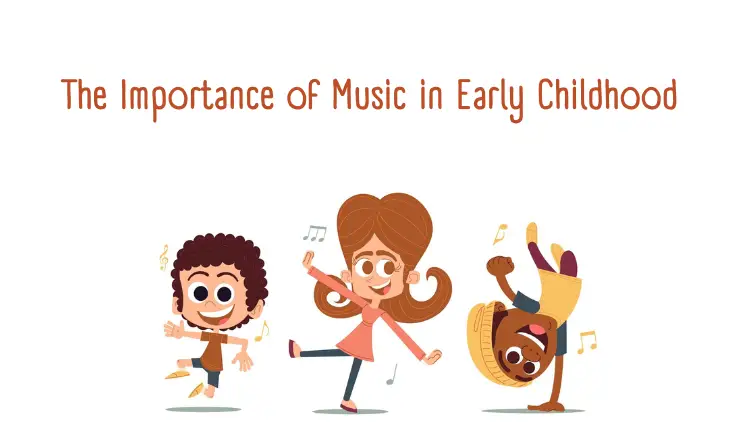
The advantages of music during these formative years are extensive, particularly in the following developmental spheres:
- Brain Development: Music fosters comprehensive brain development, forging pathways that enhance cognitive functionality in children.
- Language and Vocabulary: Melodies and rhymes expand children’s vocabulary and linguistic proficiency, facilitating correct language use.
- Auditory Perception: Musical exposure hones auditory perception, a pivotal skill for reading. This skill encompasses sound differentiation, manipulation, and comprehension.
- Sound Patterns: Songs, rhymes, and musical activities imbue children with a grasp of sound patterns that lay the foundation for literacy and numeracy.
- Motor Skills: Music aids the development of both fine and gross motor skills, integral for future reading and writing proficiency.
- Self-Expression: Music empowers children to creatively express themselves, fostering a sense of freedom and uninhibited communication.
- Memory Skills: Repetitive phrases and rhythmic patterns in children’s songs bolster memory skills, shaping auditory competence and overall memory retention.
- General Well-Being: The inherently joyful nature of music grants children a means of relaxation, stress relief, and an avenue for fostering their general well-being.
The educational value of incorporating music into preschool curricula is extensive. From cognitive development to motor skills enhancement, the advantages are numerous and interwoven. By integrating music into early learning, we harness its potential as a versatile and holistic tool that profoundly influences the multifaceted growth of young minds.
Explore these diverse activities and adapt them to suit the preferences and interests of the children in your care. Harness the power of music to enrich their early years and lay the foundation for a lifelong love of melody, rhythm, and harmony.
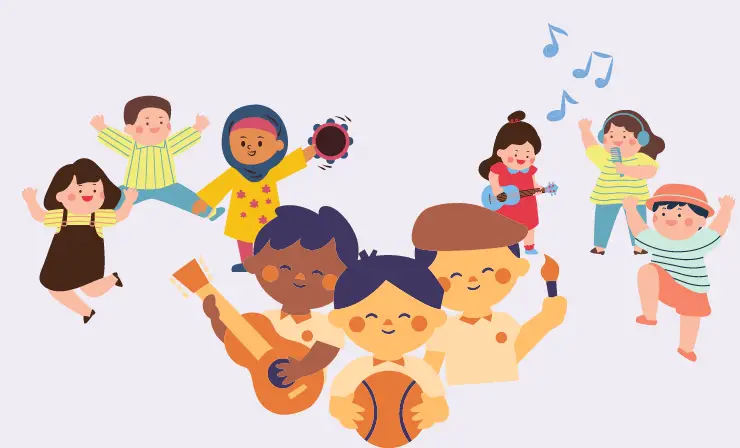
In the “Mirror, Mirror” activity, children are paired up to take turns leading and mimicking dance movements. This engaging activity requires no materials, making it easy to set up. By alternating roles of leader and follower, children enhance their motor skills and coordination, all while fostering their creativity and cooperation. As they observe, imitate, and express themselves through movement, they develop a deeper understanding of communication through nonverbal cues.
Materials : None.
Difficulty : Moderate.
Cost : None.
Benefits : This activity not only enhances motor skills and coordination but also fosters creativity and cooperation. Children learn to observe, imitate, and express themselves through movement.
This video showcases an illustrative implementation of the Mirror music activity. By watching the video, you can gain insights into conducting the activity yourself and potentially discover new creative approaches.
“Freeze Dance” turns dancing into an exciting rhythmic experience. With the help of a music player, children are encouraged to move and groove to their favorite tunes. When the music suddenly stops, they must freeze in their tracks, challenging their self-control and rhythm recognition. This activity isn’t just about dance; it’s about enhancing gross motor skills, rhythm awareness, and the ability to anticipate changes in music.
Materials : Music player.
Difficulty : Easy.
Cost : Low.
Benefits : This classic activity encourages gross motor skills, rhythm recognition, and self-control. It helps children develop a sense of anticipation and active listening.
This video serves as an excellent addition to your Freeze Dance activity. By playing the video, you can enhance the enjoyment of the activity. It’s sure to be a hit with kids and provide plenty of fun.
“Color What You Hear” intertwines auditory and visual experiences. By providing classical music as a backdrop, children color intricate designs that resonate with the music’s theme. This artistic endeavor enhances creativity and fine motor skills while encouraging a unique interpretation of music through visual representation. Through the selection of colors, children establish a connection between the auditory and visual realms, enriching their sensory understanding.
Materials : Classical music, coloring sheets, crayons.
Difficulty : Easy.
Cost : Low.
Benefits : Beyond enhancing listening skills and creativity, this activity promotes the connection between auditory and visual experiences. Children learn to interpret music in a unique way.
By viewing this video, you’ll gain a clear understanding of the fundamental principles behind the Color What You Hear activity. The process is straightforward and highly enjoyable.
“If You’re Happy” combines music, action, and language to create an interactive experience. Gathered in a circle, children sing along to a classic song while performing corresponding actions. This activity not only boosts memory recall and physical coordination but also nurtures emotional expression and social engagement. As children synchronize their movements with the lyrics, they immerse themselves in a world of play and connection.
Materials : Music player.
Difficulty : Easy.
Cost : None.
Benefits : This interactive singing activity not only engages children in music but also reinforces cognitive and physical development. It cultivates memory, language, and social skills.
Display this engaging video to the children. The instructions are simple: both you and the kids mimic the gestures performed by the characters in the video while singing along with the song.
In the “Musical Bell Shaker Craft,” children become both crafters and musicians. By assembling homemade bell shakers using simple materials like bells, pipe cleaners, and chopsticks, they create instruments that produce delightful sounds. Through shaking their shakers, children explore sensory stimulation and rhythm, enhancing their fine motor skills and creative expression. This activity transforms crafting into a multisensory adventure.
Materials : 2 paper plates, ribbons (multiple colors), jingles, a perforator, a marker
Difficulty : Easy.
Cost : Moderate.
Benefits : Beyond the sheer joy of making music, this craft activity enhances fine motor skills and creativity. Children actively engage in assembling the shaker, fostering a sense of accomplishment.
View the video for comprehensive step-by-step instructions on crafting a paper tambourine.
The “Homemade Den Den Drum” activity invites children to craft their version of a traditional Japanese musical instrument. Using a wooden spoon, string, and beads, children create a drum that mimics the sound of rain. As they hold and roll the drum, they immerse themselves in the auditory sensation, fostering a curiosity for cultural diversity and traditional music. This activity blends crafting with cultural exploration.
Materials : Wooden spoon (or 2 paper plates), string, beads, decorations.
Difficulty : Easy.
Cost : Moderate.
Benefits : Creating this unique drum introduces children to cultural diversity and traditional musical instruments. It also sharpens fine motor skills and stimulates auditory senses.
This video provides a comprehensive introduction to creating a Den Den Drum. Follow the detailed steps outlined and enjoy the final result.
With the “DIY Xylophone,” children step into the role of instrument makers. Using paper towel rolls and rubber bands, they construct a xylophone that introduces them to concepts of pitch and melody. As they experiment with different lengths to produce distinct tones, they engage in hands-on learning that develops problem-solving skills and nurtures their love for musical exploration.
Materials : Colored paper, glue, rubber bands, yarn.
Difficulty : Middle.
Cost : Low.
Benefits : This hands-on activity not only introduces children to basic musical concepts like tones but also enhances their problem-solving skills. Assembling the xylophone involves creativity and dexterity.
Follow the instructions presented in the video to craft your own DIY Xylophone. Feel free to experiment with different paper colors and xylophone sizes. The creative outcome is in your hands.
“Homemade Rainstick” brings the auditory magic of rainfall into children’s hands. By crafting a rainstick using everyday materials, they create an instrument that produces soothing rain-like sounds. As they tilt and shake their creations, they explore sensory delight while connecting with the rhythms of nature. This activity not only fosters creativity but also nurtures an appreciation for the auditory wonders of the natural world.
Materials : Cardboard roll, tape, nails, filler material.
Difficulty : Middle
Cost : Low.
Benefits : This craft encourages sensory exploration and imagination. Children not only create an instrument but also experience the auditory magic of rain through their creation.
Follow the step-by-step guidance provided in the video to craft your own Rainstick. Keep in mind that children might require assistance when working with nails.
Through the “DIY Outdoor Music Station,” children transform ordinary objects into a symphony of sounds. By repurposing cans, baking pans, and flower pots, they design an outdoor musical space. This hands-on exploration encourages them to experiment with different materials to produce various tones. The activity sparks creativity, imagination, and a sense of wonder as children orchestrate their unique outdoor musical compositions.
Materials : Cans, baking pans, flower pots, outdoor structure.
Difficulty : Moderate.
Cost : Low.
Benefits : This activity combines the joy of music with outdoor play. It promotes creativity, spatial awareness, and experimentation as children explore the various sounds produced by different materials.
Watch the instructional video to learn how to create an Outdoor Music Station. Feel free to engage children in the process of crafting this enjoyable musical setup.
“I’m a Little Teapot” brings song and movement together in a playful activity. As children gather in a circle, they sing the familiar tune and embody the actions of a teapot. Through dance and coordination, they express themselves physically and rhythmically. This activity enhances gross motor skills, rhythm awareness, and imaginative play, enveloping children in the joy of song and dance.
Materials : Music player.
Difficulty : Easy.
Cost : None.
Benefits : This classic song engages children in movement and rhythm while fostering a sense of fun and playfulness. It’s a fantastic way to promote physical activity and coordination.
Play the video for children, featuring a delightful and simple song. Join in the fun by singing along and imitating the dance movements demonstrated by Bella.
“Painting with Sound” elevates artistic expression by adding a musical twist. By attaching bells to paintbrushes, children create visual artwork while responding to auditory cues. As the music plays, their brushstrokes harmonize with melodies, translating music into visual masterpieces. This multisensory experience encourages creativity, imagination, and a unique connection between sound and sight. Access comprehensive instructions for crafting brushes by following the link.
Materials : Bells, paintbrushes, paint.
Difficulty : Low.
Cost : Low.
Benefits : This multisensory activity combines artistic expression with auditory stimulation. Children create visual art while responding to the auditory cues provided by the bells.
This video offers peaceful and calming piano melodies suitable for the described music activity. The addition of bells on the brushes will harmoniously complement the musical experience.
The “Rhythm Building Music Activity” introduces children to musical notation and rhythm patterns. By matching labeled notes to toothpicks and space, they engage in a cognitive challenge that encourages critical thinking and pattern recognition. Through hands-on participation, they develop an understanding of musical structures while refining their auditory discrimination skills. Find extra guidance for this activity by clicking on the provided link.
Materials : Notes, toothpicks, rhythm cards.
Difficulty : Moderate.
Cost : Low.
Benefits : This advanced activity introduces children to musical notation, rhythm, and coordination. It promotes critical thinking, pattern recognition, and auditory discrimination.
Observe an alternative approach to conducting this activity in the video. It’s simple and enjoyable. Just play the video and witness your children clapping to the rhythm demonstrated.
“Describe What You Hear” cultivates active listening and verbal expression. Children listen to a song and articulate what they hear in the music. This activity enhances their ability to describe musical elements like tempo, dynamics, and instruments. By sharing their observations and feelings, they develop a richer vocabulary for discussing and appreciating music.
Materials : Music player.
Difficulty : Easy.
Cost : None.
Benefits : This activity encourages active listening and verbal expression. Children develop vocabulary to describe musical elements such as tempo, pitch, and dynamics.
This video offers a selection of 9 distinct music tracks, making it perfect for the Describe What You Hear activity. Utilize these tracks for an enjoyable experience.
In “Move Like The Animals,” children embrace their inner animals through dance. To energetic music, they mimic various animal movements, such as hopping like frogs or soaring like birds. This imaginative play promotes creativity, physical activity, and storytelling. By embodying different creatures, children enhance their coordination and learn about the diverse movements found in nature.
Materials : Music player.
Difficulty : Easy.
Cost : None.
Benefits : Through imaginative play, this activity promotes creativity, physical movement, and knowledge of different animals. Children learn about body coordination and engage in storytelling.
Play the entertaining video featuring a fun song. Encourage kids to imitate animal movements after Hartmann. They are sure to enjoy this engaging activity.
“Alphabet Sounds And Actions” merges music and literacy, transforming learning into an engaging experience. Children sing the alphabet song while performing actions related to each letter’s sound. This activity strengthens letter-sound associations, phonemic awareness, and gross motor skills. As they move and sing, children engage both their bodies and minds in learning.
Materials : Music player.
Difficulty : Easy.
Cost : None.
Benefits : This activity combines music with literacy. Children associate sounds with letters and engage in kinesthetic learning by performing actions related to each letter.
Utilize this captivating video to assist your children in learning the alphabet through an enjoyable method. Encourage kids to mimic gestures and sing along with Bella.
The “Clean Up Song” turns tidying into a musical adventure. By singing a cheerful cleaning song and dancing while they tidy up, children learn the value of responsibility and teamwork. This activity fosters a positive attitude toward chores, making them enjoyable through the power of music and movement. As they dance and clean, children learn the importance of taking care of their environment in a fun and interactive way.
Materials : Music player.
Difficulty : Easy.
Cost : None.
Benefits : This activity transforms a daily chore into a fun and cooperative experience. Children learn responsibility and teamwork while enjoying music and movement.
Play this humorous cleaning-up song to entertain your child and make the cleaning process enjoyable and fun.
Music Can Change the Mood
Have you ever noticed how your favorite song can instantly bring a smile to your face? Music possesses a unique ability to influence emotions. Just as certain songs can calm your mind, others can help release pent-up frustration. The same holds true for children. Music can be a powerful tool to regulate their intense emotions or provide an outlet for their boundless energy. Whether they’re bouncing off the walls or need a moment of serenity, music serves as a versatile and effective mood enhancer.
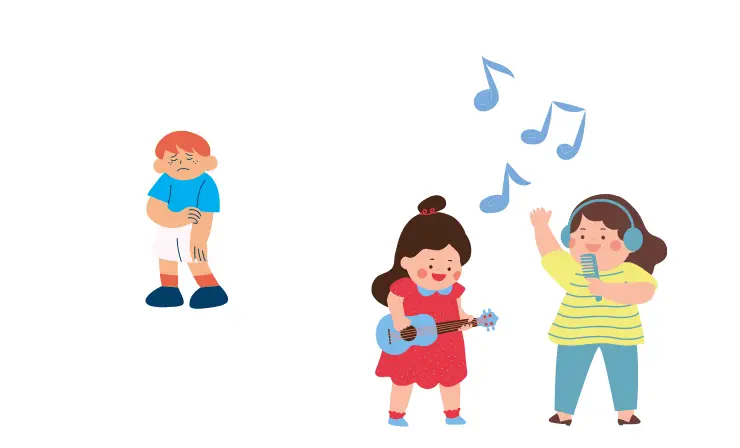
Music is a Teacher
Were you acquainted with the fact that a well-developed sense of rhythm not only contributes to a child’s musical abilities but also has a positive correlation with the refinement of fine motor skills, such as using scissors effectively? The cognitive skills involved in deciphering and distinguishing musical tones also play a pivotal role in honing phonemic awareness, which is a fundamental skill for becoming proficient readers. Remarkably, the auditory processing skills cultivated through music can directly translate to enhanced language processing.
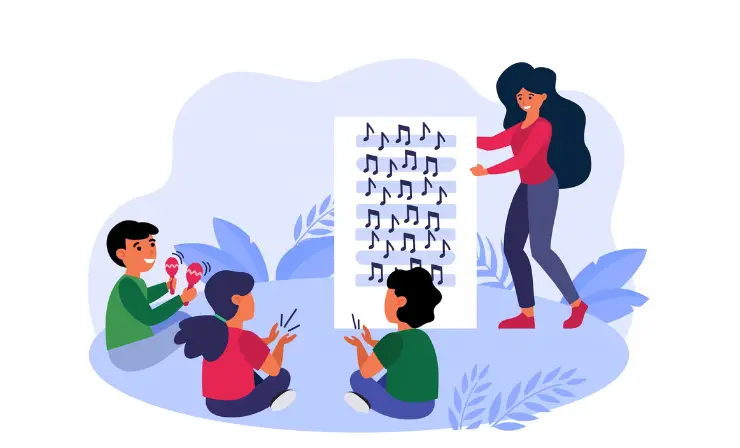
Moreover, the interactive nature of music and movement activities aids preschoolers in gaining better control over their bodies. Through rhythmic movements, they learn to regulate their motor skills, spatial awareness, and overall physical coordination. This newfound mastery over their physicality extends its benefits beyond dance floors, as it significantly contributes to improved performance in various sports and physical activities.
Useful Resources
Conclusion
The journey of introducing music to preschoolers is a delightful and educational endeavor. These music and movement activities for preschoolers offer a unique platform for learning, enabling children to grasp complex concepts while having fun. By engaging in these activities, parents and educators can empower children to develop essential skills that will serve them well as they continue to grow.
- Overview of 22 Low-Code Agencies for MVP, Web, or Mobile App Development - October 23, 2024
- Tips to Inspire Your Young Child to Pursue a Career in Nursing - July 24, 2024
- How Parents Can Advocate for Their Children’s Journey into Forensic Nursing - July 24, 2024
